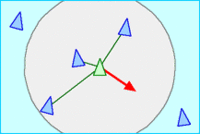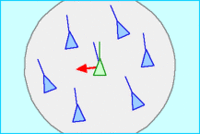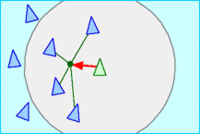鸟群算法
此词条暂由彩云小译翻译,未经人工整理和审校,带来阅读不便,请见谅。
A Boids example created in OpenGL
在[[[ OpenGL ]]中创建的 Boids 示例
Boids is an artificial life program, developed by Craig Reynolds in 1986, which simulates the flocking behaviour of birds. His paper on this topic was published in 1987 in the proceedings of the ACM SIGGRAPH conference. 引用错误:没有找到与</ref>对应的<ref>标签
}}</ref>
{} / ref
The name "boid" corresponds to a shortened version of "bird-oid object", which refers to a bird-like object.引用错误:没有找到与</ref>对应的<ref>标签 Incidentally, "boid" is also a New York Metropolitan dialect pronunciation for "bird".
}}</ref> Incidentally, "boid" is also a New York Metropolitan dialect pronunciation for "bird".
} / ref 顺便说一句,“ boid”也是纽约都市方言中“ bird”的发音。
页面模板:Multiple image/styles.css没有内容。
As with most artificial life simulations, Boids is an example of emergent behavior; that is, the complexity of Boids arises from the interaction of individual agents (the boids, in this case) adhering to a set of simple rules. The rules applied in the simplest Boids world are as follows:
As with most artificial life simulations, Boids is an example of emergent behavior; that is, the complexity of Boids arises from the interaction of individual agents (the boids, in this case) adhering to a set of simple rules. The rules applied in the simplest Boids world are as follows:
与大多数人工生命模拟一样,Boids 是突发行为的一个例子; 也就是说,Boids 的复杂性来自于个体代理(这里是 Boids)遵循一系列简单规则的相互作用。在最简单的博伊德世界中适用的规则如下:
- separation: steer to avoid crowding local flockmates
- alignment: steer towards the average heading of local flockmates
- cohesion: steer to move towards the average position (center of mass) of local flockmates
More complex rules can be added, such as obstacle avoidance and goal seeking.
More complex rules can be added, such as obstacle avoidance and goal seeking.
可以添加更复杂的规则,如避障和寻找目标。
The basic model has been extended in several different ways since Reynolds proposed it. For instance, Delgado-Mata et al.引用错误:没有找到与</ref>对应的<ref>标签
|doi= 10.1007/s00354-007-0009-5}}</ref>
| doi 10.1007 / s00354-007-0009-5} / ref
extended the basic model to incorporate the effects of fear. Olfaction was used to transmit emotion between animals, through pheromones modelled as particles in a free expansion gas. Hartman and Benes引用错误:没有找到与</ref>对应的<ref>标签
|doi= 10.1002/cav.123}}</ref>
10.1002 / cav. 123} / ref
introduced a complementary force to the alignment that they call the change of leadership. This steer defines the chance of the boid to become a leader and try to escape.
introduced a complementary force to the alignment that they call the change of leadership. This steer defines the chance of the boid to become a leader and try to escape.
引入了一种补充力量,他们称之为领导权的更迭。这头牛决定了它成为领导者并试图逃跑的机会。
The movement of Boids can be characterized as either chaotic (splitting groups and wild behaviour) or orderly. Unexpected behaviours, such as splitting flocks and reuniting after avoiding obstacles, can be considered emergent.
The movement of Boids can be characterized as either chaotic (splitting groups and wild behaviour) or orderly. Unexpected behaviours, such as splitting flocks and reuniting after avoiding obstacles, can be considered emergent.
Boids 的运动可以表现为混乱(分裂的群体和野生行为)或有序。意想不到的行为,比如分散羊群和避开障碍后的团聚,可以被认为是紧急的。
The boids framework is often used in computer graphics, providing realistic-looking representations of flocks of birds and other creatures, such as schools of fish or herds of animals. It was for instance used in the 1998 video game Half-Life for the flying bird-like creatures seen at the end of the game on Xen, named "boid" in the game files.
The boids framework is often used in computer graphics, providing realistic-looking representations of flocks of birds and other creatures, such as schools of fish or herds of animals. It was for instance used in the 1998 video game Half-Life for the flying bird-like creatures seen at the end of the game on Xen, named "boid" in the game files.
Boids 框架通常用于计算机图形学,提供鸟群和其他生物的逼真表现,比如鱼群或动物群。例如,在1998年的视频游戏《半条命》中,在游戏结束时,在游戏文件中被命名为“ boid”的类似鸟类的飞行生物就使用了这个名字。
The Boids model can be used for direct control and stabilization of teams of simple Unmanned Ground Vehicles (UGV)[1] or Micro Aerial Vehicles (MAV)[2] in swarm robotics. For stabilization of heterogeneous UAV-UGV teams, the model was adapted for using onboard relative localization by Saska et al.[3]
The Boids model can be used for direct control and stabilization of teams of simple Unmanned Ground Vehicles (UGV) or Micro Aerial Vehicles (MAV) in swarm robotics. For stabilization of heterogeneous UAV-UGV teams, the model was adapted for using onboard relative localization by Saska et al.
Boids 模型可以用于群机器人中简单的无人地面车辆(UGV)或微型飞行器(MAV)团队的直接控制和稳定。为了稳定异质 UAV-UGV 团队,Saska 等人将该模型用于板载相对定位。
At the time of proposal, Reynolds' approach represented a giant step forward compared to the traditional techniques used in computer animation for motion pictures. The first animation created with the model was Stanley and Stella in: Breaking the Ice (1987), followed by a feature film debut in Tim Burton's film Batman Returns (1992) with computer generated bat swarms and armies of penguins marching through the streets of Gotham City.[4]
At the time of proposal, Reynolds' approach represented a giant step forward compared to the traditional techniques used in computer animation for motion pictures. The first animation created with the model was Stanley and Stella in: Breaking the Ice (1987), followed by a feature film debut in Tim Burton's film Batman Returns (1992) with computer generated bat swarms and armies of penguins marching through the streets of Gotham City.
在提议的时候,雷诺兹的方法代表了一个巨大的进步相比,传统的技术用于电脑动画电影。第一部与模特合作的动画片是1987年的《史丹利和斯特拉: 破冰》(Stanley and Stella in: Breaking The Ice,1987) ,之后是1992年蒂姆 · 伯顿(Tim Burton)的电影《蝙蝠侠归来》(Batman Returns,1992) ,电脑合成的蝙蝠群和成群的企鹅穿过哥谭市。
The boids model has been used for other interesting applications. It has been applied to automatically program Internet multi-channel radio stations.引用错误:没有找到与</ref>对应的<ref>标签
}}</ref>
{} / ref
It has also been used for visualizing information引用错误:没有找到与</ref>对应的<ref>标签
}}</ref>
{} / ref
and for optimization tasks.引用错误:没有找到与</ref>对应的<ref>标签
|doi= 10.1504/IJICA.2009.031778}}</ref>
| doi 10.1504 / IJICA. 2009.031778} / ref
See also
References
- ↑ Min, Hongkyu; Wang, Zhidong (2011). Design and analysis of Group Escape Behavior for distributed autonomous mobile robots. IEEE International Conference on Robotics and Automation (ICRA). doi:10.1109/ICRA.2011.5980123.
- ↑ Saska, Martin; Jan, Vakula; Libor, Preucil (2014). Swarms of micro aerial vehicles stabilized under a visual relative localization. IEEE International Conference on Robotics and Automation (ICRA). doi:10.1109/ICRA.2014.6907374.
- ↑ Saska, Martin; Vojtech, Vonasek; Tomas, Krajnik; Libor, Preucil (2012). Coordination and Navigation of Heterogeneous UAVs-UGVs Teams Localized by a Hawk-Eye Approach (PDF). IEEE/RSJ International Conference on Intelligent Robots and Systems (IROS).
- ↑ Lebar Bajec, Iztok; Heppner, Frank H. (2009). "Organized flight in birds" (PDF). Animal Behaviour. 78 (4): 777–789. doi:10.1016/j.anbehav.2009.07.007.
External links
- Live In-Browser 3D Simulation of Bird Flocking Behavior in Unity3D – Open Source implementation for Windows, Linux and Mac
- GLSchool - part of XScreenSaver software
模板:Collective animal behaviour
Category:Artificial life
类别: 人工生命
Category:1986 software
类别: 1986软件
This page was moved from wikipedia:en:Boids. Its edit history can be viewed at 鸟群算法/edithistory


